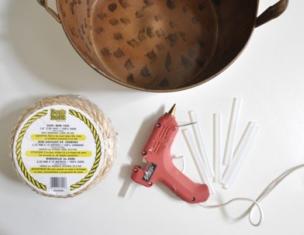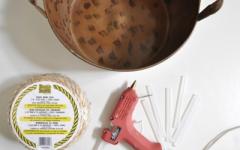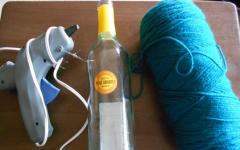You will need
Yarn (70% sheep wool, 30% alpaca wool; 90 m / 50 g) - 750 (800-850-900) Mr blue; Spokes number 6; Circular spokes number 6 40 cm long.Patterns and schemes
Pattern "Spit with rubber band"
Knit according to the scheme A. In the width of the loop to distribute the description in the instructions. Height to repeat from the 1st to the 4th r. / Circuit.
Pattern "Central Spit"
Knit according to the scheme B, rapport \u003d 47 p. Height to repeat the designated rapports.
Knitting density
22 p. X 25 r. \u003d 10 x 10 cm, associated with the pattern "Spit with rubber band";47 p. X 25 r. \u003d 23 x 10 cm, is associated with the Pattern "Central Spit";
17 p. X 25 r. \u003d 8.5 x 10 cm, connected to the middle loops of the Central Spit.
Pattern

Completing of the work
Back
Dial 94 (104-114-124) p. And for the plank knit 4.5 cm \u003d 12 p. The pattern of "braids with rubber band".Next, the hinges are distributed as follows and in the middle to add to the 1st p. 1 p. \u003d 95 (105-115-125) P: Krom., 20 (25-30-35) p. Pattern of "Spit with a rubber band", while starting from arrows A, 3 (4-5-6) repeat the rapport again (\u003d 5 p. Between the arrows) and finish at the arrows b, 3 p. Insidant glades (see page A2), 47 p. Pattern "Central Spit", 3 p. Pouring glaolds, 20 (25-30 -35) P. Pattern "Spit with rubber band", with 4 (5-6-7) repeat the rapport (\u003d 5 n. Between arrows), chrome.
After 35.5 cm \u003d 88 p. From the bottom plank, close on both sides for the armor 1 time at 2 p. And then refund on both sides for the plans from each 6th p. 2 times on 1 p. And in each 4th p. 6 times 1 p. (In each 6th r. 5 times 1 p. And in each 4th p. 3 times on 1 p. - In each 6th r. 7 times 1 p. And in The next 4th p. 1 time 1 p. - In the next 8th p. 1 time 1 p. And in each 6th p. 7 times 1 p.) \u003d 75 (85-95-105) p.
After 16 (18-20-22) cm \u003d 40 (46-50-56) p. From the beginning of the prugi, close on both sides for the shoulder bevels 1 time 2 (2-3-4) p., then in each 2nd p. 5 times 2 p. And 3 times 3 p. (8 times 3 p. - 4 times 3 p. And 4 times 4 p. - 8 times 4 p.).
After 7 cm \u003d 18 p. From the beginning of the shoulder SKOs, close the remaining 33 p.
Before
Knit, as a back, but after 16 (18-20-22) cm \u003d 40 (46-50-56) p. From the beginning of the prugi, close on both sides for the shoulder ices 1 time 3 (4-5-6) p., then in each 2nd p. 1 time 3 (4-5-6) p. And 3 times 4 (5-6-7) p.Simultaneously with the beginning of the shoulder bellows, close for a deeper cutting of the neck, the average 27 p. And both sides finish separately.
For rounding, close along the inner edge in every 2nd p. 1 time 3 p., 1 time 2 p. And 1 time 1 p.
Finish the second side symmetrically.
Left sleeve
Dial 49 (54-59-64) p. And for the plank knit 4.5 cm \u003d 12 p. The pattern of "braids with rubber band".Then the loops are distributed as follows and in the 1st p per average of 21 p., Evenly distributed, reduce 4 (3-4-3) p. \u003d 45 (51-55-61) P: Krom., 10 (13- 15-18) P. Picture of "Spit with Elastic" pattern, while starting from the arrow A, 1 time to check the rapport (\u003d 5 n. Between the arrows) and finish the arrows b (2 times repeat the rapport (\u003d 5 n. Between the arrows) and finish at the arrows b - start the arrows A, 2 times repeat the rapport (\u003d 5 n. Between the arrows) and finish the arrows b - 3 times repeat the rapport (\u003d 5 n. Between the arrows) and finish the arrows b), 3 . Pouring stroit, 17 p. Pattern "Central Spit" from the arrow A to B, 3 p. Insurance glaolds, 10 (13-15-18) P. Pattern "Spit with rubber band", while repeating rapport (\u003d 5 n. Between the arrows) (2 times repeat the rapport (\u003d 5 p. Between the arrows) and finish the arrows b - 3 times repeat the rapport (\u003d 5 n. Between the arrows) - 3 times repeat the rapport (\u003d 5 n. between arrows) and finish at arrows b), chrome.
For the bevels, add on both sides in 11 (9-7-7-m) p. From the plank 1 time 1 p., then in every 10th p. 6 times and in every 8th p. 3 times (in each 8th r. 8 times and in every 6th r. 3 times - in each 6th r. 13 times - in each 6th r. 9 times and in every 4th p. 5 times) 1 p. \u003d 65 (75-83-91) p. Added loops include "Spit with rubber band".
After 40.5 (38.5-36.5-34.5) cm \u003d 102 (96-92-86) p. From the plank, close on both sides 1 time 2 p., then close on both sides for the plans of the bevels in each 2-p. 13 (12-10-10) times 1 p. And 3 (6-9-11) 2 p. \u003d 23 p.
After 9.5 (11.5-13.5-13.5) cm \u003d 24 (28-34-38) p. From the last plane, closure from the left edge 1 time 3 p. And in each 2nd p. 5 times 4 p.
Right sleeves
Right sleeve knit symmetrically.Hood
To dial 139 p. And knit the "braids with a rubber band" pattern, while starting with 3 p. Before the 1st arrow, repeat the rapport (\u003d 5 n. Between the arrows) and finish 6 p. After the 2nd arrow.After 3 cm \u003d 6 p. From the plank knit for the fold 2 r. Wrong stroke.
After 17 cm \u003d 42 p. From the set of a row to peck 2 p. Together with an invalible on both sides of the middle 3 p. \u003d 119 p. These renovation repeat 14 times in each 2-p. \u003d 91 p. To complete the closure of the remaining 91 p.
Assembly
Run your shoulder and regulated seams (see Alignment Tags).On the circular spokes to type 110 p. And knit 3 cm \u003d 6 circuit. A pattern of "braids with a rubber band", while repeating the rapport (\u003d 5 n. between the arrows). Loops close.
Run the rear seam of the hood. The front edge of the hood over the fold line is unscrewed on the wrong side and sew. Insert a hood in the neck behind the baker, with the average 9 cm leave free. Twink cord with a length of 130 cm and go to the hooded hood. Perform the seams of sleeves and side seams.
Chest girth (finished product):
Small - 102 cm
Medium - 107 cm
LARGE - 114.5 cm
Extra-Large - 122 cm
2 Extra-Large - 133 cm
Materials
Yarn Patons Classic Wool (100% Wool, 100 g / 192 m) 8 (9-9-10-11) Motkers, Circular Speakers 4 mm and 4.5 mm, detachable zipper
Knitting density
21.5 p. And 28 r. \u003d 10x10 cm on the spokes 4.5 mm the main pattern
Description
Back
On the knitting needles of 4 mm to type 100 (105-112-119-130) and knit the face of 12 rows, to the trail. A row to connect a set edge and loops on the knitting needles to get a chance. Surrive trail. Row Ozn.P., evenly adding 7 (9-9-9-12) p. Go to the knitting needles 4.5 mm and continue to work the main pattern:
1 row: 2 persons. P., * 2 Izn.P., 1 persons. P., 2 Izn., 2 persons. P., Repeat from * to the end of the row.
2 row: 2 izn.p., * 2 times (1 persons. P., 1 Izn P.), 1 persons. P., 2 Izn., Repeat from * to the end of the row. Repeat the last 2 rows and knit for height 42 (43-44.5-44.5-44.5) cm from the coupling edge. At the beginning of the trail. 2 rows Close for the armor of sleeves 9 (9-11-11-11) clauses and knit wishes height 24 (25.5-25.5-26.5-28) See at the beginning of the trail. 2 rows for shoulder skates Close 13 (14-14-16-19) p., Then another 13 (14-15-16-20) p. At the beginning of the trail. 2 rows. In the next. Row to close the remaining 37 (40-41-42-42) p.
Burlap pocket (2 pcs)
On the knitting needles 4.5 mm dial 32 p. And knit 8 rows of facechair, move the loop to add. Spin.
Left shelf
On the spokes of 4 mm to type 47 (54-57-61-64) and knit 8 rows to knit 8 rows into the next. Face row knit Iznp. until later. 6 loops - close 2 p. And knit out. to end. Track. A row: knit persons. P., typing 2 loops over the closures. Continue the work with an invented stroy another 2 rows. In the next. A row to connect the loops on the spokes and the set of the edges as for the back. Track. A row: knit out. P., evenly adding 2 (6-6-6-6) p. Go to the knitting needles 4.5 mm and continue to work the main pattern to a height of 7.5 cm from the connecting row. Craman cutout:
1 row: knit knit 7 p. Pattern, 32 persons. Burlap pockets with add. Spokes, turn, transfer the remaining loops to add. Spin.
2 row: 32 izn.p., 7 p. Pattern.
3 row: knit 8 p. Pattern, 31 persons.
4 row: 31 izn.p., 8 p. Pattern. Repeat the last. 2 rows again.
7 row: knit 9 p. Pattern, 30 persons.
8 row: 30 izn.p., 9 p. Patter. Repeat the last 2 rows 2 more times.
13 row: knit 10 p. Pattern, 29 persons.
14 row: 29 Ozn.p., 10 p. Patter. Repeat the last 2 rows 2 more times.
19 row: knit 11 p. Pattern, 28 persons.
20 row: 28 Ozn.P., 11 p. Pattern. Repeat the last 2 rows 2 more times.
Continue work in the same way, adding 1 p. To the main pattern, until there are 14 loops. In the next. (42 row) Close 25 loops of burlap pocket and peel 14 p. Patter. Transfer postponed loops on working needles and knit:
1 row: 1 persons. P., 1 Ubament (remove 1 p., 1 persons. P. and stretch through the removed), knit the pattern to the end of the row.
2 row: knit the main pattern, at the end of the row to plunge 2 persons.
3 row: 2 people. Picture, to the end of the row.
4 row: knit with a pattern, at the end of a row to plunge 2 izn.p.
5 and 6 row: knit both 3 and 4 rows.
Repeat the last 6 rows for another 6 times, cut off the thread and transfer the remaining 35 (46-49-53-56) p. On extra. Spin. In the next row to connect the loops: knit 14 loops with an additional pattern. Spokes and pending loops. On the spokes 49 (60-63-67-70) p. Knit to height 42 (43-44.5-44.5-44.5) cm from the connecting row and continue to start the formation of the sleeve armor as for the back. At an altitude of 16.5 (18-18-18-19), see the premium to begin forming the neck of the neck: to close 8 (12-12-12-12) and knit the pattern to the end of the row. Next, make a drop of 1 p. In the line of the neckline in each row in the trail. 6 (11-11-12-8) p. At the height of the arm of the sleeves, as for the backrest, perform the shoulder slut and close the remaining 13 (14-15-16-20) p.
Right shelf knit symmetrically left.
Sleeve
On the knitting needles 4 mm to dial 55 (55-55-60-60) n. And knit both for the back, after performing the chandency. In the next. row knit out. P., evenly adding 3 (3-3-5-5-5) p. Go to the knitting needles 4.5 mm and continue to work with the main pattern, making the addition of 1 p. On each side, first in the 3rd row and further Each 4 row, so far on the spokes will be 88 (94-90-97-99) p., then in each 6 row, it will be 102 (108-108-113-117) (108-108-113-117) n. Knit sleeve to height 48 (49.5-51 -52-53.5) cm from the connecting row and in the next. Row close all loops. Put markers on each side, retreating from the upper edge of 4.5 (4.5-5.5-5.5-5.5) cm at the bottom.
Hood
Left part: Screw to the needles 4.5 mm 61 p. And knit:
1 row: Ozn.P.
2 row: * 2 Iznp., 1 persons. P., 2 Iznp., 2 persons. P., Repeat from * to the last. 5 loops, finish row - 2 Izn.P., 1 persons. P., 2 Ozn.P.
3 row: * 2 times (1 persons. P., 1 Izn.P.), 1 persons. P., 2 Izn., Repeat from * to the last. 5 loops, finish a number - 2 times (1 persons. P., 1 Izn.P.), 1 persons. Repeat the last 2 rows to a height of 20.5 cm from the set of the edge. At the beginning of the trail. A number of subsidiaut 1 p., Make a drop in every 2nd row 11 times (on the spokes of 49 loops), to train another 1 row and close all loops.
The right side of the hood is symmetrically.
Sew the right and left part of the hood. Dial on the edge of the cutout 120 p. And to peel 3 rows of ez. smooth. Track. Row: 4 izn.p., close 2 p., Knit Izn.P. until later. 6 loops, finish a row - close 2 loops, knit out. to the end of the row.
Track. A row: knit persons. P., typing 2 p. Slit another 7 series of events. stroy and in the next. Row close all loops. Make a chance and sew the edge to a set row.
Assembly
With persons. Parties to dial 30 hinges along the pocket cutter, to pluck 1 row of persons. And close the loops. Seafing the pocket of the pocket to the iso. side of the shelves. Run the shoulder seams and sew a hood along the neckline. On the knitting needles of 4 mm to dial on the edge of the right shelf 117 (120-125-127-130) p., To peck 1 row of izn.p. And close all loops. Also do on the edge of the left shelf.
Purify 2 cords with a convenient way of 163 cm long and 87 cm. To stretch them through the resulting chance at the bottom of the product and in the hood. Insert the sleeves and perform the rest of the seams.
A hood or a capor can be both a separate detail of your clothing, and the addition to the usual switch / sweater. Hoods are very loved by children and teenagers. Especially organic the hood looks at children's sweaters, trendy Hoodies, jackets and coats. Coat, jacket with a hood, not only fashionable, but also functionally. In the snow, rain, strong wind hood will save you from unpleasant weather phenomena. Today we will tell you how to tie a hood knitting needles.
Knit hood with knitting needles in different ways. The easiest way is to tie a rectangle and sew it one of the sides.
Knit a hood separately from the sweatshirt. We recruit the required amount of loops on straight knitting needles. The loops should be exactly as much as the loops along the entire length of the neck plus the staks for the fasteners. Knit a rectangle up to the height of the head plus 3-4 cm. The pattern can be used the same as on the shoes.
Pattern of a hood knitting needles:

The second method - you can raise the loop in the neck of the coal neck and start knitting the main pattern of the hood according to the method described above.
How to knit a hood - collar knitting
In knitting, along with a classic hood, reminiscent of the sock heel, a hood collar is especially common. You can perform it in several ways. Here is the easiest of them.
The line of the neck on the pattern of the backrest and passes remains unchanged, only the dimensions of the clasp bar and the hood are planned. Tie a back and shelves, leaving the neck loop open. Sew the product, put on one knitted loop of the neck and, starting from point A, on the front side of the work, lie for a number of facial loops. Loops to the point and renote to the right needle, without told. Next, perform a hood with a pattern of a plank, such as a handful, adding the loop in the middle of the hood behind (see the "+" sign) or the edge of the hood.
When the height of the canvase reaches 35-38 cm, finish the work of the auxiliary thread, after ironing, depart it and sew the open loops with a "loop in a loop".



There is another way to unsightening the hood.
For a classic hood you need to dial loops along the edge of the neck. In order to be neatly typing on the front side. Secure the thread at the beginning of the row and with the help of the knitting needles (or hook) start through the loop on the product stretching the working thread. The loops remain on the needle. Drawing a loop need to tie 2 rows with a simple facial stroy.
Next, the hood knives shortened rows. To do this, check the next facial row not to the end, turn knitting, make the nakid, and again do not communicate with a number of hinges, turn knitting. Thus, one side of the hood is tied first, then the second fit. Thus, knit the hood of the desired length. Then we close the loop of the side.
After that, the middle part knits. When viscating the middle part, we pick up the side loops and end knitting. Several rows along the edge of the hood can be seen by English elastic or garbage in crochet. This is how the exemplary hood scheme looks like.
Interesting models with a hood from the Internet
Blue coat with hood
Beautiful and stylish model. Coat decorated with large flowers and branches with leaves behind, and in front it is a simple model.
Breast girth: 86 (97.105. 113, 120) See Size: XS (S, M, L, XL).
You will need: 12 (12. 13. 13. 14) MOTOKS BRIGGS & LITTLE ATLANTIC yarn (100% wool. 124 m / 11Vg), color - 73, red
- circular spokes number 10-12 with a length of 40 and 80 cm or other size to achieve the required knitting density
- Petaperzhatel for Kos
- 6 large buttons
- Markers for knitting
- Needle for yarn
- 5 pins for loops or remnants of unnecessary yarn.
Size 43 * 61 cm.
This is a trend model from Vogue Knitting magazine.
Knitted Hood Mocha Hoodie Hat from Sandi Prosser
The hood fit across, ranging from the front to the rear and then the vertical seam is performed.
Size 55 - 56, 57 - 58. The length of the circumference on the bottom of the product (neck) - 47, 5 (52.5). Height 25cm.
Hood with ears
To knit, you will need: Lana Gold Plus yarn (51% acrylic, 49% wool, 140 m / 100 g) - 200 g of beige color, knitting needles No. 5, 3 buttons, hook, syntheps.
Schrah with a hood
Dimensions: 116 / 122-128 / 134-140 / 146 152/158. You will need 650-700-750-800 g Yarh yarn Schachnmayr SMC Cotton Time (100% cotton. 88 m / 50 g); Spokes number 3 and No. 3.5; Circular Spokes No. 3.5; auxiliary needle; 7-8-7-8 buttons.
Scarf-hooded knitting
Scarf dimensions: Length 210 cm, width 30 cm. Hoodline: 72x84 cm.
For knitting scarf-hoods, 10 yarn motals will be required (75% wool, 25% silk; 220 m / 10 g); Spokes of 7 mm, auxiliary needles for brass, hook 7 mm, hinge holders.
Basic mating.
Filming knitting: facial loops in each row;
Facial smooth: facial loops in face rows, hinges in the involneling rows;
Spit: knit 16 loops according to schemes A and in where only the front rows are shown (in the wrong rows knit in the figure), repeating vertically 1-10 rows;
Edge loops: knit facial in each row.
Knitting density:
13 p. And 20 p. \u003d 10x10 cm facial sting thread in 2 additions;
16 p. Patterns with braids \u003d 7.6 cm in width.
Interesting models with a hood on our site:
Yellow Cape Hooded
Dimensions: 42 (46).
Materials: 1000 (1 150) Gram of yarn "Merinos Otto" (100% Merino wool, 50 grams \u003d 90 meters), Spokes No. 3.5 and No. 4, Hook No. 2.
Types of mating: Hollow gum, 2 × 2 gum, persons. smooth, ezd. Speed.
Knitted tunic with a hood
To knit tunic you will need: Catania yarn (100% cotton; 50 g / 125 m): 250 (300; 350) G № 00106 white, 300 (350; 400) g № 00164 dark blue. Spokes number 2.75 and 3. Circular spokes number 3.
Hooded vest
Dimensions of the vest: 36/36 (40/42) 44/46.
For knitting, you will need: 400 (400) 450g. Windsor purple yarn (55% of merino wool, 31% of the royal mohair, 14% polyamide, 110 m / 50 g); Spokes number 4.5; Hook number 4.
Scarf with hood
The hit of this winter is a hood, smoothly turning into a scarf. The thing is not only fashionable, but also very comfortable.
You will need: the yarn "secret of success" (100% wool, 250 m / 100 g) - 200 g of purple color, knitting needles.
Coat with hood
You will need: 1700 grams of 1700 g of walnut yarn Mondial Merino Maxi (50% Merino wool, 50% acrylic, 60 m / 100 g); Straight and auxiliary spokes number 8.
Melange jacket with a hood
Jacket with a hood tied in two threads.
Size: S-M-L-XL - XXL - XXXL.
You will need: 350-400-450-450-500-550 g Fabel yarn from Garnstudio Colors No. 161 (Rose Dream) and 350-400-450450-500-550 g. Colors No. 153 (TEX MEX): Figures 5 mm, 6 -6-6-7-7-7 metal buttons.
Coat size: OG 90 cm.
To knit coat, you will need: 700 g of thread, NR knitting needles. 5.5; 4 large buttons.
Vest with hood
Dimensions of the vest: 38-42
You will need: 750 g of blue yarn Linie 270 Faro (60% wool, 40% polyacryl. 80 m. 50 g) double-sided transparent zipper 50 cm long straight knitting needles # 5 and No. 6 long circular spokes No. 5 Hook number 5.
Knitted models with a hood for children
Striped sleeveless hooded
Clearflower dimensions: 92 (104). You will need: 100 g of orange and bright pink, 50 (100) g of yarn of color cyclamen (100% polyamide, 90 m / 50 g); Straight Spokes number 3 and 4; Fugged Spokes number 3.
Coat for a girl with a hood
Size: 68/74 (74/80) 80/86.
You will need: 300 (400) 400gr melange yarn Linie Miranda and 200 gr Orange yarn Linie Champ (100% Merino wool, 70m / 50 g); Spokes number 7-7.5; Hook number 5,5; 3 buttons.
Size 2-3 years. You will need: "Popular" yarn (50% wool, 45% acrylic, 5% acrylic volumetric, 133 m / 100 g) - 400 g of gray, residues of fine yarn gray, knitting needles №4.5 and №2,5, 4 buttons.
Hooded jacket for boy
Size: 110/116. You will need: 450 g beige yarn Cool Wool (100% merino wool, 160 m / 50 g); Spokes number 4; Hook number 3.5; Zipper zipper 40 cm long.
Weather changed, and not to depend on its whims, it is convenient to keep the warm and practical wardrobe under your hand. A beautiful and cozy male knitted cardigan will become an excellent gift for a man of any age. The article presents a wide selection of models with schemes, and therefore learn to knit this thing will not be so difficult.
Rules wearing
Cardigan - clothes for every day. It is appropriate over the blouse or under the jacket. If the style of clothing does not imply free wearing, pay attention to the landing in your shoulders.
The optimal length is slightly above the hip, so as not to create an unnecessary volume in the waist area.

The length of the sleeve is checked just like a shirt - the model in size sleeve closes the protruding bones of wrist crossed in front of them. Ideal materials - natural. Cotton is universal for all seasons. For cold weather, a thing with a collar-clamp or hood is suitable. Thin cotton cardigan is appropriate under the jacket. The cardigan should be harmonized in color, style with the rest of the clothes.
For each image
We present to your attention various models that are able to interest even the most picky modes of mod. With this review of questions about what option to choose for knitting will not remain.

For young and daring
An informal cardigan with an asymmetric clasp will emphasize your personality. Detailed description of manufacturing in the photo.



Noble beige
Volumetric cardigan with volumetric pattern, collar-sock, on buttons. Suitable a slim high man.


Elegant and strict
Two-breasted cardigan with Kosos will demonstrate to others that they have a serious and practical man in front of them, and he will use his owner not only at the beginning of autumn, like replacing the jacket, but also in winter under the upper clothes.

Description of the model and knitting diagram are presented in the illustration:

Invitation to walk
This cardigan is suitable for a traveler who loves long-term hiking:

From the description of the schemes and patterns can be found in the photo.

In the paints of the forest
Cozy elongated model with a bulk pattern, characterized by the colors of a rich "natural" gamma. Has a hood. Buttoned on buttons.


On buttons
Volumetric classic light gray cardigan. The attached schemes will help you in performing this model.



Return grunge
This long cardigan free silhouette with a hood is simple and practical. Such a model is perfect for young people as casual wear.

It will take:
- woolen yarn about 1000 g of sandy color;
- circular spokes number 5 and 6, stocking spokes number 6;
- buttons in the tone.
Product circuit:

The product is suitable for dimensions 48-50, 52-54, 56-58; Large size parameters are indicated in brackets. Knitting techniques are used: sweating, pearl pattern, rubber band.
Detailed description of manufacturing in the photo:



Asked me to tie a male jacket with a hood. Lightning and sleevetles. The yarn used from Aliza Lana Gold. 8 SOTKS grew the model spied here.Http: //abcknit.ru/? P \u003d 3608 But the calculations are completely different. This is not the master of jacket, but the figures are like them. Meet !!! My spruce jacket !!! 


 And some photo process
And some photo process 






 Thanks for attention!!
Thanks for attention!!
R. S.Smolkaval threw the idea, collect explanations together here. But, as I wrote that I knit better than I describe, then do not judge my explanations. Copy everything here from the dialogue.
Insert lightning.
Http://www.liveinternet.ru/users/irisha-sr/post322175793/ Here is a wonderful master class! The only thing I was gained loop along the edge of the plank from the edge. Three loops. Nakid, three loops, nakid and so to the end. Spokes number 3 (basic canvas on №4) in height three rows. Then the approval thread row and closed. From the reverse side as of the edges. First you need to break the eyes to understand where the loops pull out, but adapting goes quickly. Also, three rows in the height and additional thread of the row and closed. (It did not shoot on the thread) by an intention from the second side. Then this case disappeared. (!!! But before that, I was already postponed before this product !!! - it is necessary) and then on the master class Irudova Irudova. The thread for sewing took from the same yarn, but divided into two.
Set around the edge of the sleeve.
Thank you! Of the two edge two loops, and from the third two loops. That is, one loop for both walls of the edge, the second for the front wall. Probably it is possible with Nakid, and then knit them crossed, but I have not tried. But now I would not pick up from the edge, but from the loops of the first row. When set from the edge, holes can be formed. Therefore, I was completely tightened by a typal row.
I got just. From the edges, which we have at the bottom of the breakdown and almost horizontally-of one loop alone, then on the mock and in the height of three four. I counted the loop and made the calculation of the sleeves. YES YES. Here is one example.httpps: //www.youtube.com/watch? V \u003d Q6LRKY_1PB8 & INDEX \u003d 9 & LIST \u003d PLHKT2V5C6BV8WKKYTDH97XFNJ4ACDOnt And then knitted from above, gaining by calculation. For example, I had it first, I first scored 12, then on each side of 4.4.17 times 1, I don't remember exactly, but I added three and two loops several times (no calculation at hand)









